Human Development Chapter Notes | Psychology Class 11 - Humanities/Arts PDF Download
| Table of contents |

|
| Meaning of Development |

|
| Factors Influencing Development |

|
| Context of Development |

|
| Overview of Developmental Stages |

|
| Infancy |

|
| Childhood |

|
| Challenges of Adolescence |

|
| Adulthood and Old Age |

|
Meaning of Development
Development refers to the series of orderly and predictable changes that start at conception and continue throughout a person's life. This includes both growth and decline, particularly noticeable in older age. It covers physical changes, mental growth, and shifts in social relationships.
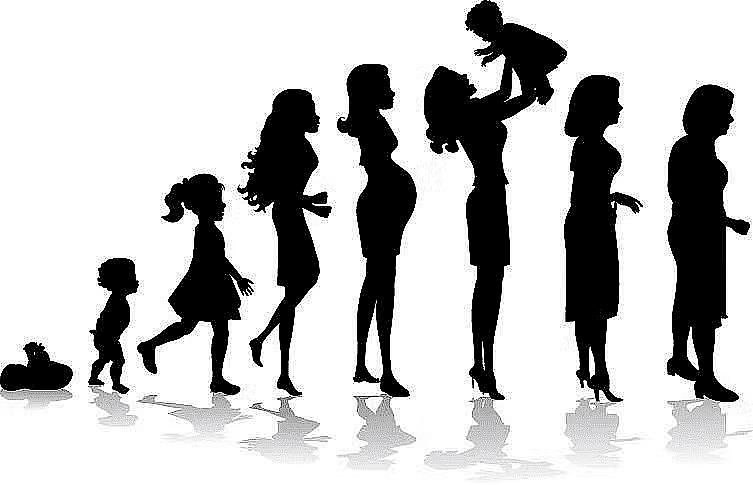
- Changes in development occur holistically, affecting various aspects of a person's life in an integrated manner.
- Development is a pattern of progressive, orderly changes starting at conception and continuing throughout life, involving both growth and decline, as seen in old age.
- Biological, cognitive, and socio-emotional processes collectively influence development.
- Biological processes, influenced by inherited genes, affect physical attributes like height, weight, and the development of organs such as the brain, heart, and lungs.
- Cognitive processes involve mental activities such as thinking, perception, attention, and problem-solving.
- Socio-emotional processes pertain to changes in an individual's interactions, emotions, and personality development. For example, a child's hug to his mother.
Life-Span Perspective on Development
Life-Span Perspective (LSP) assumes the following:
- Development Across the Life-Span: Development occurs throughout all age groups, from conception to old age, involving gains and losses that interact dynamically.
- Interconnected Processes of Development: Biological, cognitive, and socio-emotional processes are intertwined in an individual's development over their life-span.
- Multi-Directional Development: Development involves dimensions that may see growth in some aspects while decline in others. For instance, wisdom may increase with age, but speed-related tasks may decline.
- Plasticity in Development: Development is highly modifiable within an individual, with varying levels of plasticity among different people. Skills and abilities can be enhanced at any stage of life.
- Influence of Historical Conditions: Development is influenced by historical contexts, shaping individuals' experiences. Different generations face distinct influences that impact their life trajectories and decisions.
- Interdisciplinary Study of Development: Various disciplines such as psychology, anthropology, sociology, and neurosciences investigate human development, offering diverse perspectives on development across the life-span.
- Individual Responses to Contexts: Individuals interact with and respond to inherited traits, physical surroundings, social settings, and cultural influences. Life events and experiences shape individuals' trajectories and personal growth.
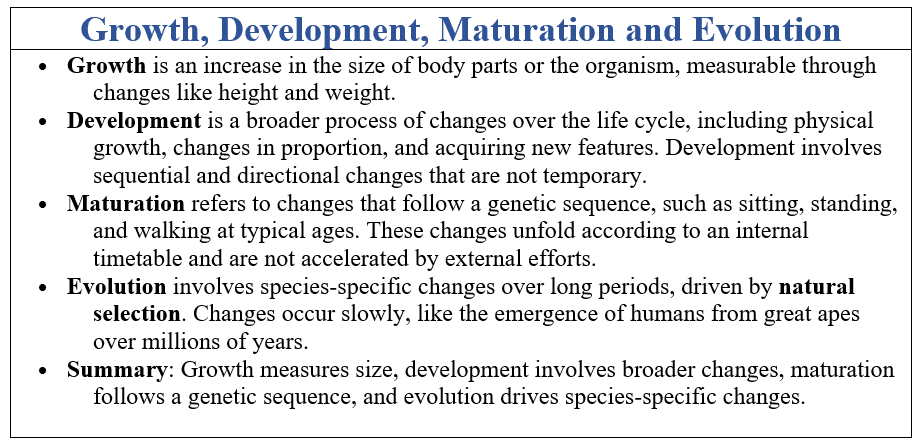 Growth, Development, Maturation and Evolution
Growth, Development, Maturation and Evolution
Factors Influencing Development
- Individual differences in physical and psychological characteristics exist due to the interaction of heredity and environment.
- Genetic codes inherited from parents are present in every cell, determining human traits and preventing growth into other species.
- Genetic transmission involves combinations of numerous genes, forming an individual's genotype, with not all genetic material visibly expressed in phenotype.
- Phenotype reflects how genotype manifests in observable traits influenced by both genetics and the environment.
- Genes provide a blueprint for development, but environmental factors play a crucial role in shaping an individual's unique characteristics.
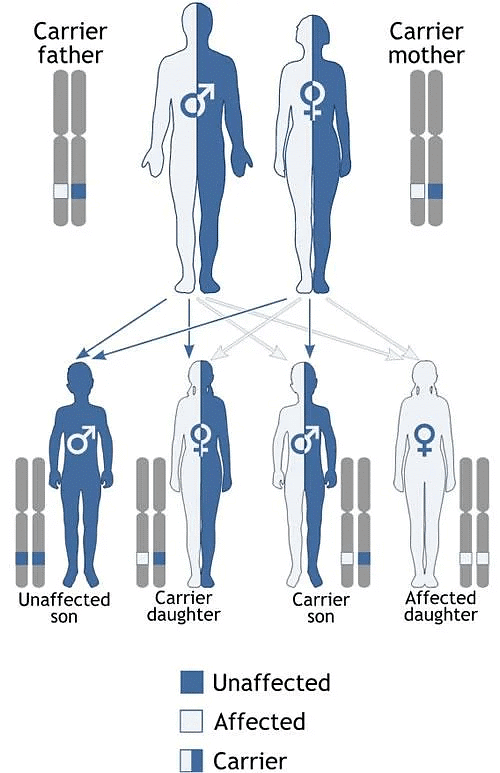
Environmental Influences on Development:
- Environmental factors interact with genes, potentially making a child slightly more extroverted.
- Parents provide genetic material and create environments that may reflect their own genetic predispositions, shaping what they offer their children.
- Children might choose environments that match their inherited traits, impacting their development.
- Environmental impacts are complex and evolve throughout life, affecting individuals from infancy to adulthood.
- Development occurs within a specific socio-cultural context, not in isolation.
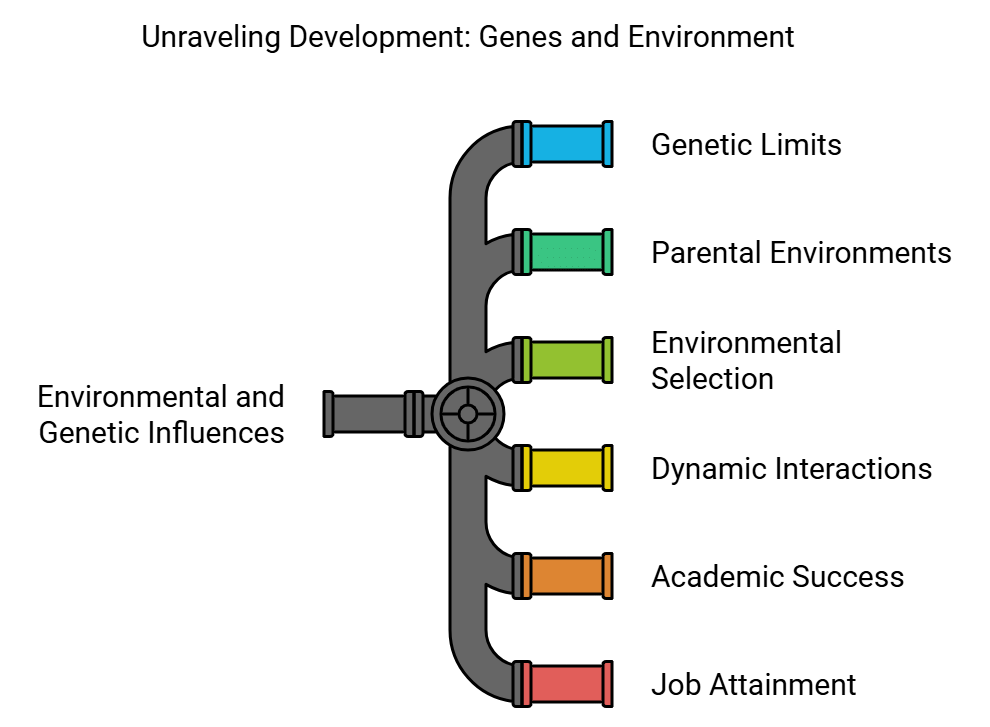
Genes Vs. Environment:
- Considerations of genetic influence versus environmental impact are essential in understanding outcomes like academic success and job attainment.
- Reflection on scenarios such as a bright class monitor's selection and a talented rural child's job prospects highlights the interplay of genetics and environment in shaping individual paths.
Context of Development
- Development happens within a specific social and cultural setting. Major life changes, such as starting school, becoming a teenager, getting jobs, marrying, having children, and retiring, are influenced by both biological developments and environmental shifts. These surroundings can change at any point throughout a person's life.
- Urie Bronfenbrenner's approach highlights how environmental factors affect personal growth. He points out that a child's development is greatly influenced by their everyday world, including daily interactions and larger social and economic conditions.
- The microsystem is the immediate setting where interactions take place, such as with family, friends, teachers, and neighbours.
- The mesosystem refers to the relationships between different environments that shape how individuals connect with others.
- The exosystem covers social events that do not directly involve the individual but still impact their immediate surroundings.
- The macrosystem includes the broader cultural setting in which a person lives.
- The chronosystem looks at events throughout a person's life and the social and historical context at the time, such as parental divorce or economic challenges, and how these affect children.
- Studies show that children from poor environments often face dull surroundings lacking books, toys, and stimulating experiences like visits to libraries or museums. They may have parents who do not serve as effective role models and live in crowded, noisy homes, leading to learning difficulties.
- Durganand Sinha's ecological model for understanding child development in India focuses on two main layers. The top layer includes home, school, and peers. Key factors in this visible layer include:
(i) home conditions regarding space, overcrowding, and available toys
(ii) quality of education and resources available to children
(iii) the nature of interactions and activities with peers from early childhood.
 Bronfenbrenner's Ecological Systems Theory
Bronfenbrenner's Ecological Systems Theory
Overview of Developmental Stages
- Development is commonly described in terms of periods or stages, reflecting varying behaviors across different life stages.
- Human life progresses through different stages, each characterized by unique features and goals.
- Individuals move through stages at different rates, with certain behaviors and skills more easily learned at specific times.
- Achievements during each stage become social expectations known as developmental tasks.
Prenatal Stage
- The period from conception to birth, lasting around 40 weeks, is the prenatal stage.
- Development during this stage is guided by genetic and environmental factors.
- Maternal characteristics like mother's age, nutrition, and emotional well-being influence prenatal development.
- Diseases like rubella, genital herpes, and HIV can impact prenatal development.
- Teratogens, environmental factors that disrupt normal development, potentially causing severe abnormalities or even death, such as drugs, infections, radiations, and pollutants, pose threats to normal development.
- Consumption of substances like drugs, alcohol, and tobacco during pregnancy can harm the foetus.
- Environmental pollutants like carbon monoxide, mercury, and lead also endanger the unborn child.
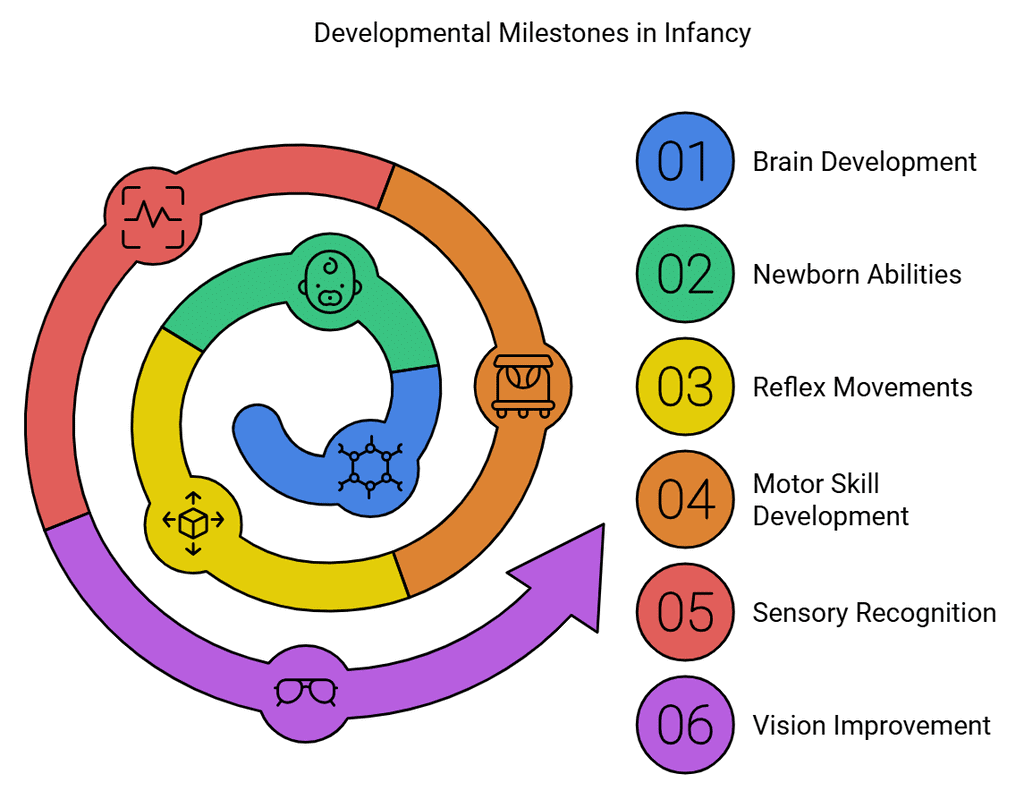
Infancy
- The brain development: The brain undergoes rapid development before and after birth. At birth, not all brain cells are present, but neural connections develop quickly.
- Newborn abilities: Newborns possess essential life functions like breathing, sucking, swallowing, and waste elimination. They can also detect sound directions, recognize their mother's voice, and imitate simple gestures.
Motor Development
- The movements of newborns are controlled by reflexes, which are automatic reactions to certain stimuli. These reflexes are inherited survival skills and form the basis for further motor skills. Some reflexes, like coughing, blinking, and yawning, last a lifetime, while others fade as the brain matures and voluntary control improves.
- As the brain grows, physical development also takes place. As infants develop, their muscles and nervous systems grow, enabling them to acquire more complex skills. Basic physical skills include grasping, reaching, sitting, crawling, walking, and running.
- The order of physical development is mostly the same across all children, with minor differences.
Sensory Abilities
- Newborns have sensory capabilities and can recognize their mother's voice shortly after birth.
- Their vision, though limited initially, evolves over the first few months. By 6 months, vision gets better, and by the end of the first year, it is almost as sharp as an adult's (20/20).
- Newborns can feel touch and pain, and they also have the ability to smell and taste.
Cognitive Development
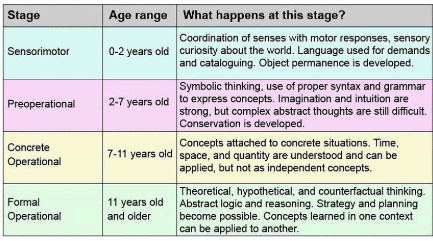 Piaget's Stages of Cognitive Development
Piaget's Stages of Cognitive Development
- Children actively construct their understanding of the world through interaction and adaptation.
- Developmental stages in children's thinking occur from infancy to adolescence, marked by distinct cognitive processes.
- During infancy, i.e. the first two years of life, children engage primarily with sensory experiences and lack object permanence initially. The child explores the world using their senses and interactions, like looking, hearing, touching, mouthing, and grasping. If something is out of sight, it is out of mind.
- Verbal communication skills begin to develop through vocalization around 3 to 6 months of age.
Socio-Emotional Development
- Babies exhibit social behaviors from birth, forming attachments and preferences for familiar faces.
- Attachment, the affectionate bond that develops between between infants and caregivers, is crucial for emotional development and security.
- Contact-comfort refers to the comfort and security that comes from physical touch and closeness, rather than just the provision of basic needs like food.
- Young children may form strong attachments to favorite toys or blankets because these items provide them with comfort and security. This was demonstrated in a study by Harlow and Harlow (1962).
- According to Erik Erikson (1968), the first year of life is crucial for attachment development, focusing on trust versus mistrust. Trust builds from physical comfort, leading to a secure view of the world.
- Responsive and sensitive parenting fosters trust and a secure attachment, enabling exploration.
- Conversely, insensitive or critical parenting can cause self-doubt in the child.
Childhood
- The child's growth slows down during early childhood compared to infancy.
- Physically, the child gains height and weight, learns to walk, run, jump, and play.
- Socially, the child's world expands from parents to family and adults at home and school.
- Children begin to acquire concepts of good and bad, developing a sense of morality.
- Increased physical capacities allow children to perform tasks independently, set goals, and meet expectations.
- Brain maturation and experiences contribute to cognitive development.
Physical Development
- Development proceeds cephalocaudally (from the cephalic or head region to the caudal or tail region) and proximodistally (children gain control over their torso before their extremities).
1. Cephalocaudal development: Control over upper body precedes lower body control. This is why an infant’s head appears proportionately larger than their body in early infancy. Additionally, when crawling, infants use their arms first and then gradually start using their legs.
2. Proximodistal development: Growth proceeds from the centre of body and moves towards the extremities At first, infants reach for objects by turning their whole body. Over time, they start to extend their arms to grab things. - As children grow older, they look slimmer due to body proportions changing.
- Brain and head grow rapidly, aiding in abilities like eye-hand coordination.
Motor Development
- Gross motor skills involve the use of arms and legs, allowing confident movement.
- Fine motor skills, such as finger agility and hand-eye coordination, improve significantly during early childhood.
- Children start to show a preference for either their left or right hand during this time.
Cognitive Development
- The child's understanding of object permanence allows them to use mental symbols to represent objects.
- Early childhood cognitive development focuses on Piaget's preoperational thought stage.
- The child gains the ability to mentally represent objects that are not physically present.
- Children engage in symbolic thought by drawing designs to represent objects.
- Egocentrism is a key feature where children see the world centered around themselves.
- Children may exhibit animism by attributing life-like qualities to inanimate objects.
- During the intuitive thought stage, children between 4 and 7 years seek answers to various questions.
- Centration is another characteristic where children focus on a single feature for understanding events.
- Between 7 and 11 years, children enter the stage of concrete operational thought.
- Concrete operations involve mental actions that are reversible and allow children to think logically.
- Concrete operational thought enables children to focus on different characteristics and appreciate different perspectives.
- Thinking becomes more flexible, allowing children to consider different solutions to problems and mentally retrace their steps if needed.
- The child cannot yet do abstract thinking, meaning they struggle with manipulating ideas without physical objects. For example, they may find it difficult to imagine concepts like lines of longitude or latitude on Earth.
Socio-emotional Development
- Developments in self, gender, and moral understanding are crucial.
- Children develop a sense of independence and initiative based on parental responses.
- According to Erikson, how parents respond to a child's self-initiated activities affects whether the child develops a sense of initiative or guilt.
- For example, providing freedom for activities like cycling, running, and skating, and answering their questions, supports and encourages the child's initiative.
- If children are made to feel their questions are useless or their games are silly, they may develop lasting feelings of guilt about their self-initiated activities.
- Self-understanding evolves from physical characteristics (eg. I am tall, I am a boy) to psychological and social aspects (eg. I am smart).
- Social comparison becomes prominent, leading to individual identity establishment.
Moral Development
- Another crucial aspect of a child's growth involves understanding the difference between right and wrong actions.
- Children learn to distinguish morality through feelings of guilt, empathy, and assisting others in need.
- Moral development progresses alongside cognitive development, as per Lawrence Kohlberg's theory.
- Kohlberg conducted studies where children were presented with moral dilemmas to assess their moral reasoning.
- Younger children, typically under the age of 9, tend to view right and wrong in terms of external authority.
Challenges of Adolescence
- The term "adolescence" originates from the Latin word adolescere, meaning "to grow into maturity."
- It's the transitional phase between childhood and adulthood, typically starting at puberty.
- The social and psychological experiences of adolescents vary with cultural context. In cultures that view adolescence as problematic, experiences differ from those in cultures where it is seen as the start of adult responsibilities.
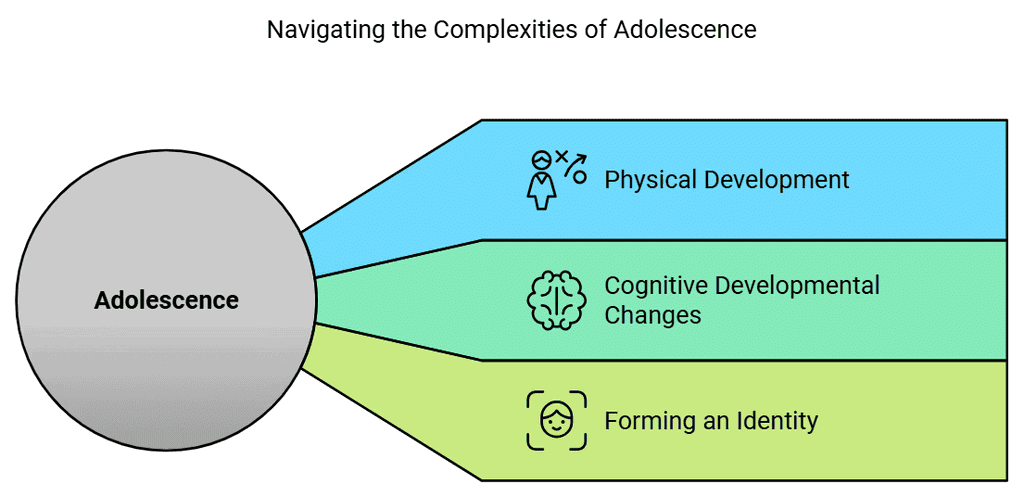
Physical Development
- Puberty or sexual maturity signifies the transition from childhood to adolescence, marked by significant physical changes and the onset of growth and sexual characteristics.
- Puberty is not an abrupt event but a gradual process, triggered by the release of hormones that lead to the development of primary and secondary sexual characteristics.
- Primary sexual characteristics pertain directly to reproduction, while secondary sexual characteristics are visible signs of sexual maturity.
- In boys, puberty manifests as accelerated growth, facial hair growth, and changes in voice. Girls typically experience a growth spurt before menarche, the onset of menstruation.
- The growth spurt usually starts around age 12 or 13 for boys and 10 or 11 for girls. Variations in the pubertal sequence are normal.
- The timing and progression of puberty can vary among individuals due to a combination of genetics and environmental factors.
- Adolescence is not just about physical changes; it also involves psychological shifts, such as increased interest in the opposite sex and heightened awareness of sexual feelings.
- Developing a sexual identity defines sexual orientation and guides sexual behavior, making it a crucial developmental task for adolescents.
Cognitive Developmental Changes
- Adolescents experience significant cognitive changes as they transition into formal operational thought between the ages of 11 and 15 according to Piaget. During this stage, their thinking becomes more abstract, logical, and idealistic, allowing them to analyze thoughts, understand others' perspectives, and reflect on societal norms.
- Adolescents shift from concrete experiences to abstract thinking, contemplating ideal characteristics for themselves and others. They compare these ideals to reality, sometimes feeling conflicted about adopting new standards.
- Adolescents employ systematic problem-solving strategies, considering multiple courses of action and seeking solutions through logical reasoning. This approach contrasts with the trial-and-error methods used in earlier developmental stages.
- Adolescents' moral reasoning becomes more flexible as they question societal norms, explore alternative moral paths, and develop personal moral codes. This may lead them to challenge conventions that clash with their ethical beliefs.
- Adolescents exhibit unique forms of egocentrism, including the imaginary audience and personal fable. The imaginary audience leads them to believe that others are constantly focused on their actions, while the personal fable fosters a sense of personal uniqueness and isolation.
- It is essential for adolescents to form a realistic view of their physical appearance that they find acceptable. The growth spurt during puberty is a significant event that includes the onset of reproductive maturity.
- Cultural differences in parenting can influence the attachment styles between children and their caregivers.
Forming an Identity
- Seeking answers to questions such as "Who am I?", "Which subjects should I study?", and "Do I believe in God?" signifies the quest to define one's sense of self or the search for identity.
- Identity encompasses one's values, commitments, and beliefs, with adolescence primarily focused on establishing an identity separate from parents.
- Adolescents engage in a detachment process to cultivate a personalized belief system, leading to conflict with parents and internal struggles, with successful resolution resulting in a newfound sense of self.
- Failure to cope with conflicting identities can lead to "identity confusion," potentially causing individuals to isolate themselves or lose their identity in the crowd.
- Adolescents may desire independence but also demonstrate dependence on parents, showcasing rapid shifts between self-assurance and insecurity.
- Seeking continuity and sameness, assuming greater responsibility, and gaining a clear sense of self are integral to the identity-seeking process during adolescence.
- Various factors like cultural background, family values, societal norms, ethnic roots, and socioeconomic status influence adolescent identity formation.
- As adolescents spend more time outside the home, peer relationships become crucial, offering opportunities for skill refinement and social behavior experimentation.
- Both parents and peers play significant roles in adolescents' lives, with conflicting situations sometimes leading to increased identification with peers.
Some Major Concerns
- Delinquency: Delinquency covers a range of behaviors, from socially unacceptable actions to criminal offenses. This includes truancy, theft, vandalism, and more. Adolescents involved in delinquent behavior often struggle with low self-esteem, trust issues, and academic difficulties. Factors like lack of parental support, family conflicts, and negative peer influences can contribute to delinquency.
- Substance Abuse: Adolescence is a critical period for the onset of smoking, alcohol, and drug abuse. Some teenagers turn to substances as a way to cope with stress or to fit in with their peers. Factors like impulsiveness, low self-esteem, and peer pressure can increase vulnerability to substance abuse. Establishing positive relationships with family and peers is crucial in preventing drug misuse.
- Eating Disorders: Adolescents may develop eating disorders like anorexia nervosa and bulimia due to societal pressures and self-image concerns. Anorexia nervosa involves extreme dieting to achieve thinness, often influenced by media portrayals of beauty. Bulimia involves binge-eating followed by purging behaviors. These disorders are more prevalent in urban settings and can have serious health implications.
Adulthood and Old Age
Adulthood
- Adulthood is characterized by responsibility, maturity, self-sufficiency, and integration into society.
- Timing and fulfillment of adult roles vary among individuals based on social contexts.
- In early adulthood, key tasks involve exploring adult living possibilities and establishing a stable life structure.
Career and Work
- Earning a living, selecting a career, and career development are crucial for individuals in their twenties and thirties.
- Entering the workforce is challenging and involves proving competence, handling expectations, and adapting to new roles and responsibilities.
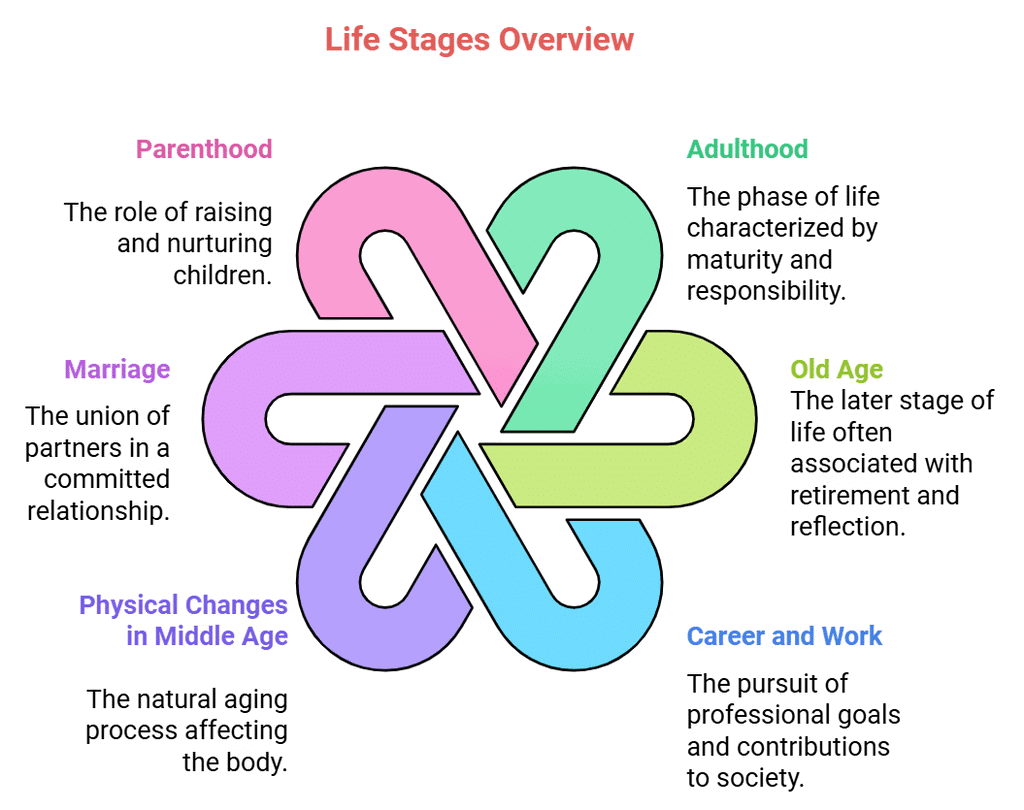
Marriage, Parenthood, and Family
- Adjustments in marriage involve understanding each other's preferences and roles, especially when both partners work.
- Parenting can be demanding but offers opportunities for personal growth and satisfaction.
- Changes in family structures due to factors like divorce or both parents working necessitate balancing responsibilities.
Physical Changes in Middle Age
- Physical changes during middle age are common and include declines in vision, hearing, and changes in appearance.
- Cognitive abilities may vary with some decline in memory but potential improvements in wisdom.
Old Age
- The definition of "old age" is evolving as people live longer.
- Challenges for the elderly include retirement, health issues, and changes in family dynamics.
- Successful aging involves effective work, positive relationships, good health, and cognitive fitness.
- Retirement can be viewed positively as a phase for pursuing personal interests.
- Elderly individuals may face issues like loneliness, dependency, and adjusting to new roles.
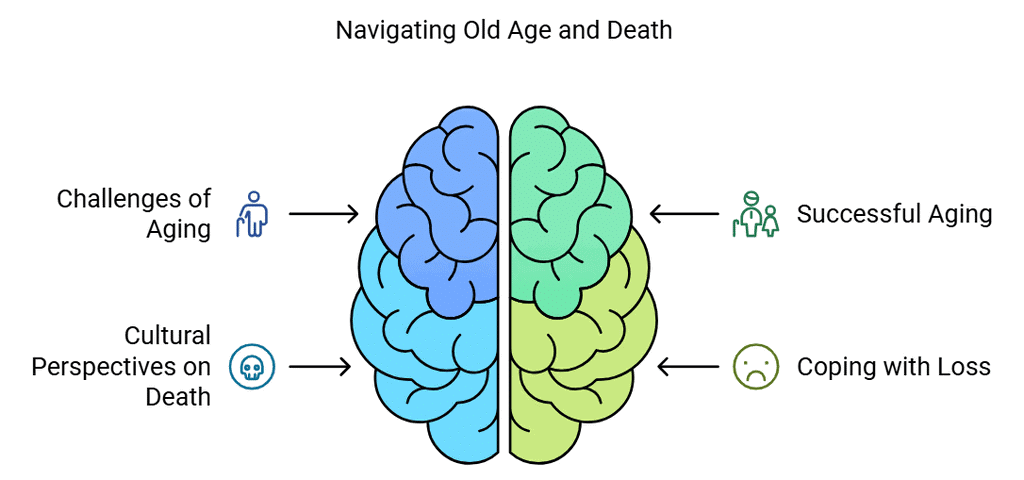
Death and Cultural Perspectives:
- Death is perceived differently across cultures, impacting how individuals cope with loss.
- Support systems from family, friends, and society play a crucial role in helping individuals through bereavement.
|
43 videos|88 docs|18 tests
|
FAQs on Human Development Chapter Notes - Psychology Class 11 - Humanities/Arts
| 1. What is the meaning of development in the context of human growth and progression? |  |
| 2. What are some factors that influence human development? |  |
| 3. How does the context of development impact an individual's growth and progression? |  |
| 4. Can you provide an overview of developmental stages from infancy to old age? |  |
| 5. What are some common challenges faced during adolescence in terms of human development? |  |
















